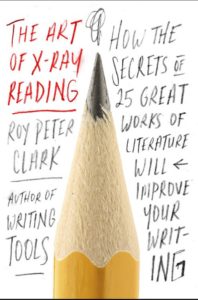 This is a great book to help someone who wants to upgrade their reading fare from genre to literary fiction. It teaches you how to pay attention to meta-textual details such as themes, symbols, voice, diction, and story structure. Attention to such details will surely enhance anyone’s reading enjoyment.
This is a great book to help someone who wants to upgrade their reading fare from genre to literary fiction. It teaches you how to pay attention to meta-textual details such as themes, symbols, voice, diction, and story structure. Attention to such details will surely enhance anyone’s reading enjoyment.
Separate chapters point out such subtleties in novels as varied as The Great Gatsby, Lolita, Madam Bovary, King Lear, Moby Dick, and many others, a total of more than 25 works in fact, as some chapters shoehorn two titles into consideration. In each case the author quotes passages from the work then comments on features an “x-ray” reader might notice.
At the end of each short chapter are a set of writing lessons – summary conclusions you should draw for x-ray reading, and sometimes writing prompts: exercises that will help you see how to use the lessons learned to improve your own writing. These are all helpful.
On the downside, the author’s “analyses” often amount to little more than extremely obvious generalizations and sometimes not even that: he simply paraphrases what the quoted passage just said.
For example, in discussing The Great Gatsby, Clark points out that sometimes objects have deeper meanings. Who knew? The ferryboat across Long Island sound might connote Charon and his ferry across the River Styx, for example. Of Shakespeare’s line, “The Queen, my lord, is dead,” he notes that it could have been, “The Queen is dead, my lord,” or “My lord, the Queen is dead.” Well, yes. Lolita, he says, “…feels more like it was written by a child who grew up with eight crayons and had just been given a box of sixty-four.”
I found Clark’s lessons and homilies not-very-informative, but a naïve reader or a beginning writer might find them helpful. Comparing Nabokov’s writing to a child with a plethora of colors is not a bad way to describe that author’s spectacular diction, just in case, for some improbable reason, you didn’t notice it on your own. And for the books I haven’t read, Clark’s excerpts were useful in conveying the tone and style of the work. So overall, I enjoyed this book and finished it in just a few hours of light reading. I’m skeptical however that I have acquired any new skill called “x-ray reading” that will improve my writing.
Clark, Roy Peter (2016). The Art of X-ray Reading: How the secrets of 25 great works of literature will improve your writing. New York: Little, Brown. 326 pp.
